Family Name: Rhamnaceae A.L. Jussieu Synonym(s): Frangulaceae DC.; Phylicaceae J. Agardh; Ziziphaceae Adans. ex Post & Kuntze
Common Name(s): amaranth family
*Number of genera/species: 55/950
List of genera records in GRIN-Global
 exposed), or seed
exposed), or seed
Fruit usually a schizocarpschizocarp:
usually dry fruit splitting between two or more locules to form distinct, indehiscent, usually one seeded segments; fruit derived from a single, superior or inferior, compound ovary; compare to mericarp splitting into 3 endocarpids sometimes explosively so, drupedrupe:
splitting into 3 endocarpids sometimes explosively so, drupedrupe:
(indehiscent drupe) a fleshy, indehiscent fruit with one more hard pits enclosing seeds, derived from single, superior, simple or compound ovary; (dehiscent drupe) a fruit with a dry or fibrous to fleshy or leathery outer husk that early to tardily breaks apart (or opens), exposing one or more nutlike pits enclosing the seeds , or capsulecapsule:
, or capsulecapsule:
a dry, dehiscent fruit derived from a compound ovary (sometimes explosively dehiscentdehiscent:
(sometimes explosively dehiscentdehiscent:
(v. dehisce) splitting open at maturity to release contents (of a fruit) ), rarely a samarasamara:
), rarely a samarasamara:
a winged, indehiscent, dry fruit containing a single (rarely two) seed(s) . Fruits 1.5–30 mm long (cultivated Ziziphus drupesdrupe:
. Fruits 1.5–30 mm long (cultivated Ziziphus drupesdrupe:
(indehiscent drupe) a fleshy, indehiscent fruit with one more hard pits enclosing seeds, derived from single, superior, simple or compound ovary; (dehiscent drupe) a fruit with a dry or fibrous to fleshy or leathery outer husk that early to tardily breaks apart (or opens), exposing one or more nutlike pits enclosing the seeds to 50 mm long, and Ventilago or Smythea samarassamara:
to 50 mm long, and Ventilago or Smythea samarassamara:
a winged, indehiscent, dry fruit containing a single (rarely two) seed(s) to 70 mm long including wings), globoseglobose:
to 70 mm long including wings), globoseglobose:
3D shape—more or less spherical to butterfly-shaped, often tri-lobed, tereteterete:
to butterfly-shaped, often tri-lobed, tereteterete:
approximately circular in cross section; width and thickness approximately equal
 to compressedcompressed:
to compressedcompressed:
flattened; in grasses, used to denote compression (not necessarily flattened) either laterally or dorsiventrally
in transection, with 1–4 seeds, often calyxcalyx:
the outer whorl of the perianth; all the sepals of a flower and stylestyle:
and stylestyle:
in a flower, the narrow and elongated part of the pistil between the stigma and the ovary; sometimes persisting in fruit persistent, sometimes with torus visible at base of fruits. SamarasSamara:
persistent, sometimes with torus visible at base of fruits. SamarasSamara:
a winged, indehiscent, dry fruit containing a single (rarely two) seed(s) winged, terminal or hemisphericalhemispherical:
winged, terminal or hemisphericalhemispherical:
2D shape—shaped like half a sphere
, and schizocarpsschizocarp:
usually dry fruit splitting between two or more locules to form distinct, indehiscent, usually one seeded segments; fruit derived from a single, superior or inferior, compound ovary; compare to mericarp , sometimes longitudinally winged. SamarasSamara:
, sometimes longitudinally winged. SamarasSamara:
a winged, indehiscent, dry fruit containing a single (rarely two) seed(s) and endocarpids or hemimericarps usually with one seed. DrupesDrupe:
and endocarpids or hemimericarps usually with one seed. DrupesDrupe:
(indehiscent drupe) a fleshy, indehiscent fruit with one more hard pits enclosing seeds, derived from single, superior, simple or compound ovary; (dehiscent drupe) a fruit with a dry or fibrous to fleshy or leathery outer husk that early to tardily breaks apart (or opens), exposing one or more nutlike pits enclosing the seeds with 1–4 pyrenespyrene:
with 1–4 pyrenespyrene:
the hard inner portion of a drupe, consisting of a bony endocarp and an enclosed seed
, each usually with one seed. CapsulesCapsule:
a dry, dehiscent fruit derived from a compound ovary few seeded. Pericarppericarp:
few seeded. Pericarppericarp:
fruit wall or fruit coat
gray, black, purple, greenish, brown, yellow, or orange (drupesdrupe:
(indehiscent drupe) a fleshy, indehiscent fruit with one more hard pits enclosing seeds, derived from single, superior, simple or compound ovary; (dehiscent drupe) a fruit with a dry or fibrous to fleshy or leathery outer husk that early to tardily breaks apart (or opens), exposing one or more nutlike pits enclosing the seeds also blue or white), shinyshiny:
also blue or white), shinyshiny:
uniformly reflecting a high proportion of incident light at all angles or dulldull:
or dulldull:
reflecting only a low proportion of incident light, with no apparent sheen , dry samarasamara:
, dry samarasamara:
a winged, indehiscent, dry fruit containing a single (rarely two) seed(s) ) schizocarpsschizocarp:
) schizocarpsschizocarp:
usually dry fruit splitting between two or more locules to form distinct, indehiscent, usually one seeded segments; fruit derived from a single, superior or inferior, compound ovary; compare to mericarp , capsulescapsule:
, capsulescapsule:
a dry, dehiscent fruit derived from a compound ovary ) or fleshy (drupesdrupe:
) or fleshy (drupesdrupe:
(indehiscent drupe) a fleshy, indehiscent fruit with one more hard pits enclosing seeds, derived from single, superior, simple or compound ovary; (dehiscent drupe) a fruit with a dry or fibrous to fleshy or leathery outer husk that early to tardily breaks apart (or opens), exposing one or more nutlike pits enclosing the seeds ), glabrousglabrous:
), glabrousglabrous:
without hairs
or pubescentpubescent:
surface relief—bearing hairs
, usually smooth. SamarasSamara:
a winged, indehiscent, dry fruit containing a single (rarely two) seed(s) striate or veiny. DrupesDrupe:
striate or veiny. DrupesDrupe:
(indehiscent drupe) a fleshy, indehiscent fruit with one more hard pits enclosing seeds, derived from single, superior, simple or compound ovary; (dehiscent drupe) a fruit with a dry or fibrous to fleshy or leathery outer husk that early to tardily breaks apart (or opens), exposing one or more nutlike pits enclosing the seeds sometimes 2–4 furrowed or wrinkledwrinkled:
sometimes 2–4 furrowed or wrinkledwrinkled:
surface relief—shallow, irregular folds and furrows covering the surface; appearing overall though crumpled and then spread out . Ceanothus capsulecapsule:
. Ceanothus capsulecapsule:
a dry, dehiscent fruit derived from a compound ovary surface variable, smooth or lobed, wrinkledwrinkled:
surface variable, smooth or lobed, wrinkledwrinkled:
surface relief—shallow, irregular folds and furrows covering the surface; appearing overall though crumpled and then spread out , crested, or with hornshorn:
, crested, or with hornshorn:
a straight or curved, slenderly conic or conoidal protrusion, resembling an animal horn
. Endocarpendocarp:
the inner layer of the pericarp, if divided into layers thin or thick, usually woodywoody:
thin or thick, usually woodywoody:
texture—consisting mainly of indurate lignified tissues, characteristic of or resembling wood
or bonybony:
very hard and rather brittle, like bone
, sometimes cartilaginouscartilaginous:
texture—firm, dense, tough, somewhat pliable, and resilient, like cartilage
. In schizocarpsschizocarp:
usually dry fruit splitting between two or more locules to form distinct, indehiscent, usually one seeded segments; fruit derived from a single, superior or inferior, compound ovary; compare to mericarp , endocarpendocarp:
, endocarpendocarp:
the inner layer of the pericarp, if divided into layers may be brightly colored compared to exocarpexocarp:
may be brightly colored compared to exocarpexocarp:
outer layer of fruit wall or pericarp, if divided into layers; note here used synonymously with epicarp and mesocarpmesocarp:
and mesocarpmesocarp:
the middle layer of the pericarp, if divided into layers .
.
Seeds often compressedcompressed:
flattened; in grasses, used to denote compression (not necessarily flattened) either laterally or dorsiventrally
or flattened, globoseglobose:
3D shape—more or less spherical to angularangular:
to angularangular:
2D shape—having sides that meet at acute or obtuse angles
, triangulartriangular:
2D shape—three relatively straight sides with distinct corners; more angular than teardrop-shaped in transection, 1–12 mm long. ArilsAril:
in transection, 1–12 mm long. ArilsAril:
(broad sense) appendicular structure that wholly or partly envelops a seed and is produced from or a modification of the funicle, raphe, or outer integument; usually fleshy or pulpy, sometimes spongy or tufted-capillate, often brightly colored present or absent, if present, fleshy, lobed or fimbriate, translucenttranslucent:
present or absent, if present, fleshy, lobed or fimbriate, translucenttranslucent:
transmitting light uniformly and diffusely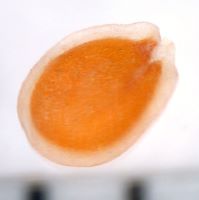 , yellow, brown or black, varying in size from inconspicuous to enclosing the seed. Seed coat gray, black, purple, brown, yellow orange, red, or cream, dulldull:
, yellow, brown or black, varying in size from inconspicuous to enclosing the seed. Seed coat gray, black, purple, brown, yellow orange, red, or cream, dulldull:
reflecting only a low proportion of incident light, with no apparent sheen or shinyshiny:
or shinyshiny:
uniformly reflecting a high proportion of incident light at all angles , crustaceouscrustaceous:
, crustaceouscrustaceous:
texture—thin, dry, indurate, and brittle
, bonybony:
very hard and rather brittle, like bone
, or leatheryleathery:
texture—moderately thick, tough, and very pliable
, smooth or furrowed, pittedpitted:
surface relief—surface with small depressions in which the areas between the hollows do not take on the appearance of a true reticular net , wrinkledwrinkled:
, wrinkledwrinkled:
surface relief—shallow, irregular folds and furrows covering the surface; appearing overall though crumpled and then spread out , or colliculose.
, or colliculose.
Embryo well developed, parallel to seed length, nearly filling seed cavity, foliatefoliate:
appearing leaf-like
, straight, rarely bentbent:
(of embryo) embryo is bent at an acute, V-shaped angle with the ends close together and generally thick cotyledons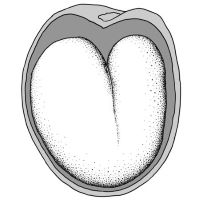 , usually green, with investinginvesting:
, usually green, with investinginvesting:
(of embryo) embryo is nearly or completely filling seed coat, straight, and axile and centric with spatulate cotyledons and covering the stalk for at least half its length; (of cotyledons) cotyledons spatulate and covering the stalk for at least half its length
or spatulatespatulate:
2D shape—like a spatula; rounded at the apex, with base long and tapered; (of embryo) embryo is straight and axile and centric with the cotyledons expanded to form the shape of a spatula or spoon; (of cotyledons) cotyledons expanded and wider than the stalk but not invested into the stalk cotyledons.
cotyledons.
Endosperm moderate to absent, usually smooth, ruminateruminate:
testa or seed coat folded into the endosperm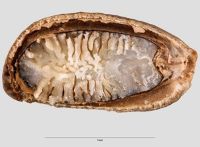 in Reynosia.
in Reynosia.
| Fruit | |
| Type | drupedrupe: (indehiscent drupe) a fleshy, indehiscent fruit with one more hard pits enclosing seeds, derived from single, superior, simple or compound ovary; (dehiscent drupe) a fruit with a dry or fibrous to fleshy or leathery outer husk that early to tardily breaks apart (or opens), exposing one or more nutlike pits enclosing the seeds  , capsulecapsule: , capsulecapsule:a dry, dehiscent fruit derived from a compound ovary  , schizocarpschizocarp: , schizocarpschizocarp:usually dry fruit splitting between two or more locules to form distinct, indehiscent, usually one seeded segments; fruit derived from a single, superior or inferior, compound ovary; compare to mericarp  , rarely samarasamara: , rarely samarasamara:a winged, indehiscent, dry fruit containing a single (rarely two) seed(s)  |
| Size range | 1.5–70 mm long |
| Shape(s) | globoseglobose: 3D shape—more or less spherical  , urceolateurceolate: , urceolateurceolate:3D shape—urn-shaped, hollow and contracted near the apex , trilobed, ellipsoidellipsoid: 3D shape—elliptic , fusiformfusiform: spindle-shaped; broadest at the middle and tapering at both ends  , ovoidovoid: , ovoidovoid:3D shape—ovate  , obovoidobovoid: , obovoidobovoid:3D shape—obovate , cylindriccylindrical: 3D shape—a cylinder, with parallel sides and a circular cross-section; tubular or rod-shaped , oblongoblong: 2D shape—much longer than broad with nearly parallel sides, corners are rounded  , triquetrous, angularangular: , triquetrous, angularangular:2D shape—having sides that meet at acute or obtuse angles , butterfly-shaped |
| Texture | dry (leatheryleathery: texture—moderately thick, tough, and very pliable or paperypapery: texture—papyraceous, chartaceous; very thin, pliable, and readily torn; like paper ), fleshy (pulpy, corkycorky: firm, relatively light, discontinuous but strongly cohesive, and resilient or spongyspongy: soft, light, discontinuous but cohesive, and somewhat resilient ) |
| Surface relief | smooth, striatestriate: surface relief—having fine, parallel lines, grooves or ridges  , veiny, 2–4 furrowed, wrinkledwrinkled: , veiny, 2–4 furrowed, wrinkledwrinkled:surface relief—shallow, irregular folds and furrows covering the surface; appearing overall though crumpled and then spread out  , crested, with hornshorn: , crested, with hornshorn:a straight or curved, slenderly conic or conoidal protrusion, resembling an animal horn or bulges |
| Color(s) | gray, black, blue, purple, greenish, brown, yellow, orange, white |
| Unique features | Dry schizocarpschizocarp: usually dry fruit splitting between two or more locules to form distinct, indehiscent, usually one seeded segments; fruit derived from a single, superior or inferior, compound ovary; compare to mericarp  or capsulescapsule: or capsulescapsule:a dry, dehiscent fruit derived from a compound ovary  , rarely a winged or not samarasamara: , rarely a winged or not samarasamara:a winged, indehiscent, dry fruit containing a single (rarely two) seed(s)  . Or fleshy drupesdrupe: . Or fleshy drupesdrupe:(indehiscent drupe) a fleshy, indehiscent fruit with one more hard pits enclosing seeds, derived from single, superior, simple or compound ovary; (dehiscent drupe) a fruit with a dry or fibrous to fleshy or leathery outer husk that early to tardily breaks apart (or opens), exposing one or more nutlike pits enclosing the seeds  with 1–4 indehiscentindehiscent: with 1–4 indehiscentindehiscent:not opening on its own, as in a fruit  , rarely dehiscentdehiscent: , rarely dehiscentdehiscent:(v. dehisce) splitting open at maturity to release contents (of a fruit)  pyrenes. pyrenes. |
| Seed | |
| Size range | 1–12 mm long |
| Shape(s) | globoseglobose: 3D shape—more or less spherical  or orbicularorbicular: or orbicularorbicular:2D shape—circular in outline, 3D shape—globose 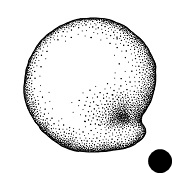 , plano-convexplano-convex: , plano-convexplano-convex:2D or 3D shape—flat on one side, convex on the other 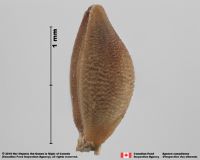 , ellipsoidellipsoid: , ellipsoidellipsoid:3D shape—elliptic , ovoidovoid: 3D shape—ovate  , obovoidobovoid: , obovoidobovoid:3D shape—obovate , oblongoblong: 2D shape—much longer than broad with nearly parallel sides, corners are rounded  , reniformreniform: , reniformreniform:2D or 3D shape—kidney-shaped  to heart-shapedheart-shaped: to heart-shapedheart-shaped:2D or 3D shape—one end has prominent double curved into two lobes, the other end angular or pointed 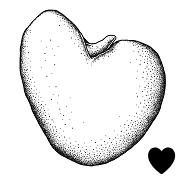 , angularangular: , angularangular:2D shape—having sides that meet at acute or obtuse angles |
| Surface relief | smooth, furrowed, pittedpitted: surface relief—surface with small depressions in which the areas between the hollows do not take on the appearance of a true reticular net  , wrinkledwrinkled: , wrinkledwrinkled:surface relief—shallow, irregular folds and furrows covering the surface; appearing overall though crumpled and then spread out  , colliculose , colliculose |
| Color(s) | gray, black, purple, brown, yellow orange, red, cream |
| Unique features | Seeds often with a dorsaldorsal: abaxial; the back of an organ; the side away from the axis (compare ventral) 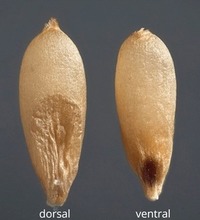 furrow, arillate or not, with large green, embryo and usually scanty to no endosperm. furrow, arillate or not, with large green, embryo and usually scanty to no endosperm. |
| Other | |
| Embryo | well developed, parallel to seed length, nearly filling seed cavity, foliatefoliate: appearing leaf-like , straight, rarely bentbent: (of embryo) embryo is bent at an acute, V-shaped angle with the ends close together and generally thick cotyledons  , usually green, with investinginvesting: , usually green, with investinginvesting:(of embryo) embryo is nearly or completely filling seed coat, straight, and axile and centric with spatulate cotyledons and covering the stalk for at least half its length; (of cotyledons) cotyledons spatulate and covering the stalk for at least half its length or spatulatespatulate: 2D shape—like a spatula; rounded at the apex, with base long and tapered; (of embryo) embryo is straight and axile and centric with the cotyledons expanded to form the shape of a spatula or spoon; (of cotyledons) cotyledons expanded and wider than the stalk but not invested into the stalk  cotyledons cotyledons |
| Nutritive tissue | endosperm moderate to absent, usually smooth, ruminateruminate: testa or seed coat folded into the endosperm  in Reynosia in Reynosia |
Worldwide
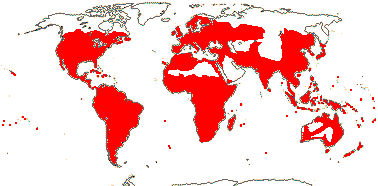
Distribution map courtesy of Angiosperm Phylogeny Website.
Alijanpoor et al. 2021Alijanpoor et al. 2021:
Alijanpoor B, Khodayari H, Assadi M, Rahiminejad M, and Megregan I. 2021. A taxonomic revision of Rhamnus L. and Atadinus Raf. (Rhamnaceae) in Iran. Phytotaxa 521: 127–158.; Ara et al. 2008Ara et al. 2008:
Ara H, Hassan MA, and Khanam M. 2008. Taxonomic study of the genus Ziziphus Mill. (Rhamnaceae) of Bangladesh. Bangladesh J. Plant Taxon 15: 47–61.; Buerki et al. 2011Buerki et al. 2011:
Buerki S, Phillipson PB, and Callmander MW. 2011. A taxonomic revision of Gouania (Rhamnaceae) in Madagascar and the other islands of the Western Indian Ocean (The Comoro and Mascarene Islands, and The Seychelles). Ann Mo Bot Gard. 98(2):157-195.; Burge and Manchester 2008Burge and Manchester 2008:
Burge DO and Manchester SR. 2008. Fruit morphology, fossil history, and biogeography of Paliurus (Rhamnaceae). Int. J. Pl. Sci. 169: 1066–1085.; Cahen et al. 2021Cahen et al. 2021:
Cahen D, Rickenback J, and Utteridge TMA. 2021. A revision of Ziziphus (Rhamnaceae) in Borneo. Kew Bulletin 76: 767–504; Callmander et al. 2008Callmander et al. 2008:
Callmander MW, Phillipson PB, and Buerki S. 2008. Revision of endemic the genus Bathiorhamnus Capuron (Rhamnaceae) in Madagascar. Adansonia 30: 151–170.; Fernández-Alonso and Arbeláez 2008Fernández-Alonso and Arbeláez 2008:
Fernández-Alonso JL and Arbeláez MV. 2008. Araracuara, un nuevo género de Rhamnaceae de la Amazonía colombiana. Anales Jard. Bot. Madrid 65: 343–352.; Figueiredo 1995Figueiredo 1995:
Figueiredo E. 1995. A Revision of Lasiodiscus (Rhamnaceae). Kew Bulletin 50(3): 495–526. https://doi.org/10.2307/4110324; Flora of Australia 2021+Flora of Australia 2021+:
Flora of Australia. Australian Biological Resources Study, Canberra. Accessed January 2021–March 2024. URL: http://www.ausflora.org.au; Flora of North America Editorial Committee 1993+Flora of North America Editorial Committee 1993+:
Flora of North America Editorial Committee, eds. 1993+. Flora of North America North of Mexico [Online]. 22+ vols. Flora of North America Association, New York and Oxford. Accessed January-March 2024. URL: http://beta.floranorthamerica.org.; Hopkins et al. 2015Hopkins et al. 2015:
Hopkins HC, Pillon Y, Stacy EA, and Kellermann J. 2015. Jaffrea, a new genus of Rhamnaceae endemic to New Caledonia, with notes on Alphitonia and Emmenosperma. Kew Bulletin 70: 42.; Hutchinson and Dalziel 1954–1972Hutchinson and Dalziel 1954–1972:
Hutchinson J and Dalziel JM, revised by Keay RWJ and Hepper FN. 1954–1972. Flora of West Tropical Africa, ed. 2, 3 Vols. 2300 pp.; Johnston 1962Johnston 1962:
Johnston MC. 1962. Revision of Condalia including Microrhamnus (Rhamnaceae). Brittonia 14(4): 332–368; Johnston 1971Johnston 1971:
Johnston MC. 1971. Revision of Colubrina (Rhamnaceae). Brittonia 23: 2–53.; Johnston 1973Johnston 1973:
Johnston MC. 1973. Revision of Kentrothamnus (Rhamnaceae). Journal of the Arnold Arboretum 54(4): 471–473. http://www.jstor.org/stable/43781800; Johnston 1974Johnston 1974:
Johnston MC. 1974. Revision of Scutia (Rhamnaceae). Bull. Torrey Bot. Club 101: 64–71.; Kellermann et al. 2005Kellermann et al. 2005:
Kellermann J, Medan D, Aagesen L, and Hilger HH. 2005. Rehabilitation of the South American genus Ochetophila Poepp. ex Endl. (Rhamnaceae: Colletieae). New Zealand J. Bot. 43:865–869.; Kirkbride et al. 2006Kirkbride et al. 2006:
Kirkbride JH, Jr, Gunn CR, and Dallwitz MJ. 2006. Family guide for fruits and seeds, vers. 1.0. Accessed September 2020-January 2022. URL: https://nt.ars-grin.gov/seedsfruits/keys/frsdfam/index.cfm .; Kubitzki et al. 1990+Kubitzki et al. 1990+:
Kubitzki K et al., eds. 1990+. The families and genera of vascular plants. 7+ vols. Berlin etc.; Lentz and Dickau 2005Lentz and Dickau 2005:
Lentz DL and Dickau R. 2005. Seeds of Central America and Southern Mexico: The Economic Species. The New York Botanical Garden Press, New York. 298 pp.; PlantNET 2021+PlantNET 2021+:
PlantNET (The NSW Plant Information Network System). 2021+. Royal Botanic Gardens and Domain Trust, Sydney. Accessed January 2021–March 2024. URL: https://plantnet.rbgsyd.nsw.gov.au; Rye 2001Rye 2001:
Rye BL. 2001. A taxonomic update of Stenanthemum (Rhamnaceae: Pomaderreae) in Western Australia. Nuytsia 13(3): 495–507. https://www.biodiversitylibrary.org/page/53424748; Schirarend and Olabi 1994Schirarend and Olabi 1994:
Schirarend C and Olabi MN. 1994. Revision of the genus Paliurus Tourn. ex Mill. (Rhamnaceae). Bot. Jahrb. Syst. 116: 333–359.; Takhtajan 2009Takhtajan 2009:
Takhtajan A. 2009. Flowering plants: Second edition. Springer Nature, Switzerland. 871 pp.; Tortosa 1993Tortosa 1993:
Tortosa RD. 1993. Revision del genero Adolphia (Rhamnaceae-Colletieae). Darwiniana 32(1/4): 185–189. http://www.jstor.org/stable/23222966; Tortosa 2005Tortosa 2005:
Tortosa RD. 2005. Johnstonia, a new genus of Gouanieae (Rhamnaceae) from Peru. Novon 15: 642–645.; Zhengyi et al. 2004+Zhengyi et al. 2004+:
Zhengyi W, Raven PH, and Deyuan H. 2004+. Flora of China [online]. 25 vols. Science Press, Beijing China & Missouri Botanical Garden, St. Louis USA. Accessed January–March 2024. http://flora.huh.harvard.edu/china/
*The number of genera and species is based on Christenhusz and Byng 2016Christenhusz and Byng 2016:
Christenhusz MJM and Byng JW. 2016. The number of known plant species in the world and its annual increase. Phytotaxa 261 (3): 201-217. https://doi.org/10.11646/phytotaxa.261.3.1, which may differ from the number of genera in GRIN-Global.